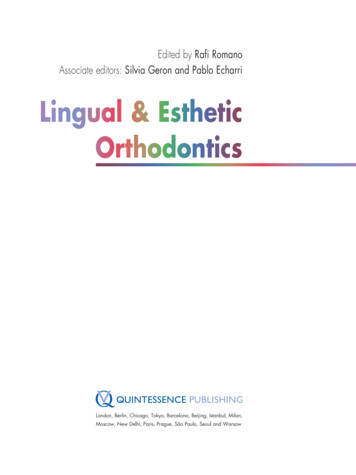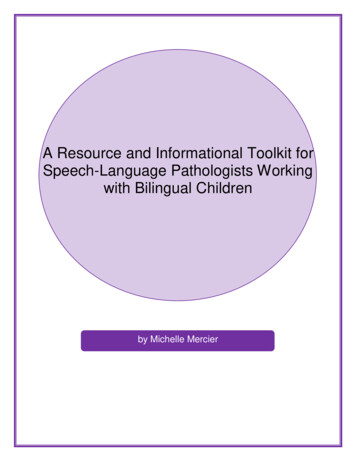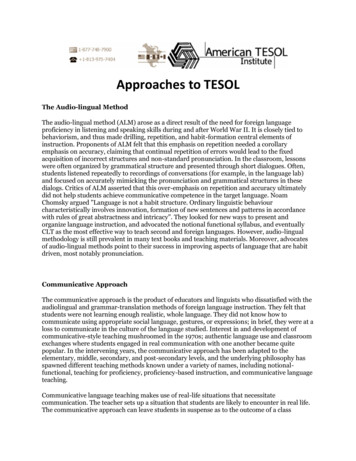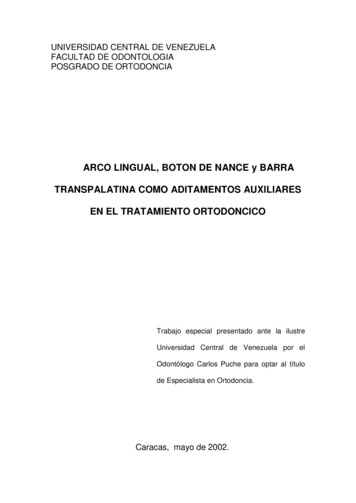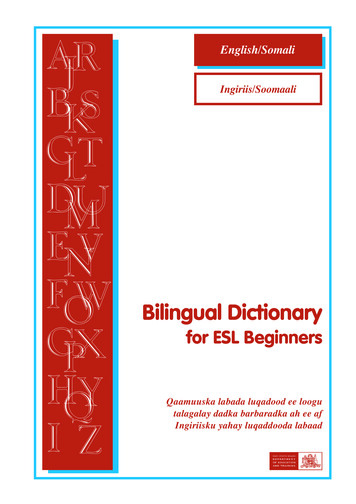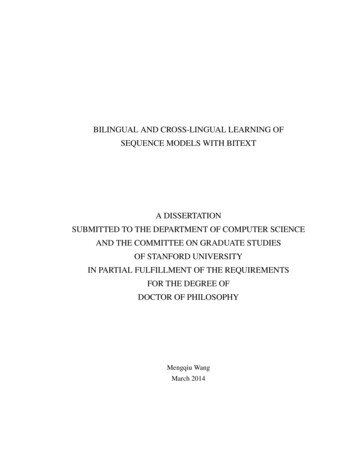
Transcription
BILINGUAL AND CROSS-LINGUAL LEARNING OFSEQUENCE MODELS WITH BITEXTA DISSERTATIONSUBMITTED TO THE DEPARTMENT OF COMPUTER SCIENCEAND THE COMMITTEE ON GRADUATE STUDIESOF STANFORD UNIVERSITYIN PARTIAL FULFILLMENT OF THE REQUIREMENTSFOR THE DEGREE OFDOCTOR OF PHILOSOPHYMengqiu WangMarch 2014
2014 by Mengqiu Wang. All Rights Reserved.Re-distributed by Stanford University under license with the author.This work is licensed under a Creative Commons AttributionNoncommercial 3.0 United States 3.0/us/This dissertation is online at: http://purl.stanford.edu/nq879qs3428ii
I certify that I have read this dissertation and that, in my opinion, it is fully adequatein scope and quality as a dissertation for the degree of Doctor of Philosophy.Christopher Manning, Primary AdviserI certify that I have read this dissertation and that, in my opinion, it is fully adequatein scope and quality as a dissertation for the degree of Doctor of Philosophy.Daniel JurafskyI certify that I have read this dissertation and that, in my opinion, it is fully adequatein scope and quality as a dissertation for the degree of Doctor of Philosophy.Percy LiangApproved for the Stanford University Committee on Graduate Studies.Patricia J. Gumport, Vice Provost for Graduate EducationThis signature page was generated electronically upon submission of this dissertation inelectronic format. An original signed hard copy of the signature page is on file inUniversity Archives.iii
AbstractInformation extraction technologies such as detecting the names of people and places innatural language texts are becoming ever more prevalent, as the amount of unstructuredtext data grows exponentially. Tremendous progress has been made in the past decade inlearning supervised sequence models for such tasks, and current state-of-the-art results arein the lower 90s in term of F1 score, for resource-rich languages like English and widelystudied datasets such as the CoNLL newswire corpus.However, the performance of existing supervised methods lag by a significant marginwhen evaluated for non-English languages, new datasets, and domains other than newswire.Furthermore, for resource-poor languages where there is often little or no annotated trainingdata, neither supervised nor existing unsupervised methods tend to work well.This thesis describes a series of models and experiments in response to these challengesin three specific areas.Firstly, we address the problem of balancing between feature weight undertraining andovertraining in learning log-linear models. We explore the use of two novel regularizationtechniques—a mixed 2 1 norm in a product of experts ensemble, and an adaptive regularization with feature noising—to show that they can be very effective in improving systemperformance.Secondly, we challenge the conventional wisdom of employing a linear architecture andsparse discrete feature representation for sequence labeling tasks, and closely examine theconnection and tradeoff between a linear versus nonlinear architecture, as well as a discreteversus continuous feature representation. We show that a nonlinear architecture enjoys asignificant advantage over linear architecture when used with continuous feature vectors,but does not seem to offer benefits over traditional sparse features.iv
Lastly, we explore methods that leverage readily available unlabeled parallel text fromtranslation as a rich source of constraints for learning bilingual models that transfer knowledge from English to resource-poor languages. We formalize the model as loopy MarkovRandom Fields, and propose a suite of approximate inference methods for decoding. Evaluated on standard test sets for five non-English languages, our semi-supervised modelsyield significant improvements over the state-of-the-art results for all five languages.We further propose a cross-lingual projection method that is capable of learning sequence models for languages where there are no annotated resources at all. Our methodprojects model posteriors from English to the foreign side over word alignments on bitext,and handles missing and noisy labels via expectation regularization. Learned with no annotated data at all, our model attains the same accuracy as supervised models trained withthousands of labeled examples.v
AcknowledgementsWords cannot express my gratitude enough for my advisor, Chris. Without a doubt, youare the best advisor I could ever hoped for. You took care of me all these years I wasat Stanford. Time and time again you pulled me up when I was drowning in my ownconfusion, supported when I left to explore the world, and received me back when I waslost. The one thing that I appreciate the most is how you always wanted the bettermentof me, even if my plans were not in the best interest of the lab or the project. You are atrue educator, an inspiration that I’ll always draw strength from. I would have never gottenwhere I am today in a million years without your support and trust. Thank you so much.I also want to thank my other committee members, Dan and Percy. Dan, I can recallthe first time we spoke, back in 2007 at EMNLP in Prague, I approached you to tell youabout the work I was doing at the time, given how famous and busy you were, I expectedsome chitchat and maybe a hand shake, but instead you sat me down on a couch and heardme out for almost half an hour. I was thinking, how can someone so smart and so famousand yet be so humble and warm? After 7 years of working with you, I still have the samewonder of how smart and nice you are. What also amazes me is how quickly you can graspthe big picture of any new ideas, and immediately point out the merit or problem with theideas. Your lifestyle is also amazing and inspiring, you always have amazing stories aboutmusic and food. Percy, you are hands down the smartest and most talented person I haveever worked with. I hope you don’t mind me telling people stories of how when we firstmet you told me that you just moved to the bay area and was looking for an apartment stay,and in one afternoon you wrote a program that scrapes all of the listings on Craigslist andplotted them out on Google maps with pricing info, lease term, property attributes, etc.,and you did that because it was easier than searching on Google or Craigslist. I alwaysvi
wonder if the world would be better or worse if academia didn’t captivate your intellectualinterest — a million brilliant startups vs. breakthrough in machine learning and NLP, hmm. . . I would like to give special thanks to Wanxiang, who not only gave me most of the ideasfor the bilingual NER work and co-authored three papers with me, but has also been awonderful friend and mentor. Other than profs, I am also super grateful of how wonderfuleveryone in the NLP group is. I will not attempt to list names here, but thank you all forinspiring me, keeping me great company when I was whining about research problems, andputting up with my bad jokes and random stories at NLP lunch. And finally, I want to thankmy family. I get overly emotional when I talk about my family, having been away fromhome for over 14 years now means a lot of sacrifice and commitment from my parents andmy grandma. They have always been supportive even when I was having doubts about mycareer. Without you I could have never made it.vii
To my mom, dad, and my grandparents.viii
1.1Overview . . . . . . . . . . . . . . . . . . . . . . . . . . . . . . . . . . .11.2Contributions of this thesis . . . . . . . . . . . . . . . . . . . . . . . . . .91.3Structure of this thesis . . . . . . . . . . . . . . . . . . . . . . . . . . . . 102Background122.1Named Entity Recognition . . . . . . . . . . . . . . . . . . . . . . . . . . 122.2Evaluation . . . . . . . . . . . . . . . . . . . . . . . . . . . . . . . . . . . 132.3Log-Linear Models for Structure Prediction . . . . . . . . . . . . . . . . . 152.4Parameter Training . . . . . . . . . . . . . . . . . . . . . . . . . . . . . . 182.5Dataset . . . . . . . . . . . . . . . . . . . . . . . . . . . . . . . . . . . . 192.62.5.1Monolingual NER . . . . . . . . . . . . . . . . . . . . . . . . . . 192.5.2Bilingual NER . . . . . . . . . . . . . . . . . . . . . . . . . . . . 202.5.3Semi-supervised NER . . . . . . . . . . . . . . . . . . . . . . . . 222.5.4Summary . . . . . . . . . . . . . . . . . . . . . . . . . . . . . . . 22Feature Templates . . . . . . . . . . . . . . . . . . . . . . . . . . . . . . . 222.6.1Generic Features . . . . . . . . . . . . . . . . . . . . . . . . . . . 232.6.2Language Specific Features . . . . . . . . . . . . . . . . . . . . . 242.6.3Distributional Similarity Features . . . . . . . . . . . . . . . . . . 25ix
3Addressing Weight Undertraining3.1Introduction . . . . . . . . . . . . . . . . . . . . . . . . . . . . . . . . . . 263.2Automatic Learning of Products of Experts . . . . . . . . . . . . . . . . . 273.33.443.2.1Logarithmic Opinion Pooling . . . . . . . . . . . . . . . . . . . . 293.2.2Automatic Induction of Elitist LOP . . . . . . . . . . . . . . . . . 313.2.3Results . . . . . . . . . . . . . . . . . . . . . . . . . . . . . . . . 363.2.4Related Work . . . . . . . . . . . . . . . . . . . . . . . . . . . . . 393.2.5Summary . . . . . . . . . . . . . . . . . . . . . . . . . . . . . . . 40Feature Noising for Structure Prediction . . . . . . . . . . . . . . . . . . . 403.3.1Feature Noising for MaxEnt . . . . . . . . . . . . . . . . . . . . . 423.3.2Feature Noising for CRFs . . . . . . . . . . . . . . . . . . . . . . 453.3.3Results . . . . . . . . . . . . . . . . . . . . . . . . . . . . . . . . 49Summary . . . . . . . . . . . . . . . . . . . . . . . . . . . . . . . . . . . 49Investigating Non-linear Architectures504.1Introduction . . . . . . . . . . . . . . . . . . . . . . . . . . . . . . . . . . 504.2Related Work . . . . . . . . . . . . . . . . . . . . . . . . . . . . . . . . . 514.3From CRFs To SLNNs . . . . . . . . . . . . . . . . . . . . . . . . . . . . 524.4Parameter Learning . . . . . . . . . . . . . . . . . . . . . . . . . . . . . . 554.5Experiments and Results . . . . . . . . . . . . . . . . . . . . . . . . . . . 564.65264.5.1Results of Discrete Representation . . . . . . . . . . . . . . . . . . 574.5.2Results of Distributional Representation . . . . . . . . . . . . . . . 594.5.3Combine Discrete and Distributional Features . . . . . . . . . . . . 604.5.4Influence of Edge Cliques . . . . . . . . . . . . . . . . . . . . . . 61Summary . . . . . . . . . . . . . . . . . . . . . . . . . . . . . . . . . . . 61Semi-supervised Learning with Bitext635.1Introduction . . . . . . . . . . . . . . . . . . . . . . . . . . . . . . . . . . 635.2Bilingual Factored Model with Constraints . . . . . . . . . . . . . . . . . . 665.2.1Hard Agreement Constraints . . . . . . . . . . . . . . . . . . . . . 685.2.2Soft Agreement Constraints . . . . . . . . . . . . . . . . . . . . . 685.2.3Alignment Uncertainty . . . . . . . . . . . . . . . . . . . . . . . . 69x
5.35.465.3.1Integer Linear Programming . . . . . . . . . . . . . . . . . . . . . 715.3.2Dual Decomposition . . . . . . . . . . . . . . . . . . . . . . . . . 775.3.3Gibbs Sampling . . . . . . . . . . . . . . . . . . . . . . . . . . . . 91Results . . . . . . . . . . . . . . . . . . . . . . . . . . . . . . . . . . . . . 995.4.1Summary of Bilingual Results . . . . . . . . . . . . . . . . . . . . 995.4.2Semi-supervised NER Results . . . . . . . . . . . . . . . . . . . . 1005.4.3Efficiency . . . . . . . . . . . . . . . . . . . . . . . . . . . . . . . 1015.5Related Work . . . . . . . . . . . . . . . . . . . . . . . . . . . . . . . . . 1025.6Summary . . . . . . . . . . . . . . . . . . . . . . . . . . . . . . . . . . . 105Projected Expectation Regularization1066.1Introduction . . . . . . . . . . . . . . . . . . . . . . . . . . . . . . . . . . 1066.2Related Work . . . . . . . . . . . . . . . . . . . . . . . . . . . . . . . . . 1086.3Approach . . . . . . . . . . . . . . . . . . . . . . . . . . . . . . . . . . . 1116.47Approximate Inference . . . . . . . . . . . . . . . . . . . . . . . . . . . . 716.3.1CLiPER . . . . . . . . . . . . . . . . . . . . . . . . . . . . . . . . 1126.3.2Hard vs. Soft Projection . . . . . . . . . . . . . . . . . . . . . . . 1166.3.3Source-side noise . . . . . . . . . . . . . . . . . . . . . . . . . . . 117Experiments . . . . . . . . . . . . . . . . . . . . . . . . . . . . . . . . . . 1186.4.1Dataset and Setup . . . . . . . . . . . . . . . . . . . . . . . . . . . 1196.4.2Weakly Supervised Results . . . . . . . . . . . . . . . . . . . . . . 1196.4.3Semi-supervised Results . . . . . . . . . . . . . . . . . . . . . . . 1226.4.4Efficiency . . . . . . . . . . . . . . . . . . . . . . . . . . . . . . . 1246.5Error Analysis and Discussion . . . . . . . . . . . . . . . . . . . . . . . . 1246.6Summary . . . . . . . . . . . . . . . . . . . . . . . . . . . . . . . . . . . 125Conclusions127xi
List of Tables2.1Summary statistics for the datasets used in this thesis . . . . . . . . . . . . 232.2NER feature templates. . . . . . . . . . . . . . . . . . . . . . . . . . . . . 243.1Results of NER on CoNLL-03 and MUC-6/7 datasets. . . . . . . . . . . . 373.2OOV and IV results breakdown. . . . . . . . . . . . . . . . . . . . . . . . 383.3CoNLL-03 summary of results. . . . . . . . . . . . . . . . . . . . . . . . . 484.1Results of CRF versus SLNN, over discrete feature space. CoNLLd standsfor the CoNLL development set, and CoNLLt is the test set. Best F1 scoreon each dataset is highlighted in bold. . . . . . . . . . . . . . . . . . . . . 574.2Results of CRF versus LNN, over discrete feature space. . . . . . . . . . . 584.3Results of CRF versus SLNN, over continuous space feature representations. 604.4Results of CRF and SLNN when word embedding is appended to the discrete features. Numbers shown are F1 scores. . . . . . . . . . . . . . . . . 604.5With or without edge cliques features (none, edge) for CRF and SLNN. F1scores are shown for both discrete and continuous feature representation. 615.1ILP results on bilingual parallel test set. . . . . . . . . . . . . . . . . . . . 755.2Dual decomposition results on bilingual parallel test set. . . . . . . . . . . 875.3Joint alignment and NER test results. . . . . . . . . . . . . . . . . . . . . . 895.4Speed and accuracy trade-off on the dev set using the position selectionheuristic. . . . . . . . . . . . . . . . . . . . . . . . . . . . . . . . . . . 945.5Gibbs sampling results on bilingual parallel test set. . . . . . . . . . . . . . 955.6Results of enforcing Gibbs Sampling with global consistency. . . . . . . . . 97xii
5.7Results summary of bilingual tagging experiment. . . . . . . . . . . . . . . 995.8Semi-supervised results using uptraining. . . . . . . . . . . . . . . . . . . 1005.9Timing stats of the sum of decoding and model uptraining time. . . . . . . 1026.1Raw counts in the error confusion matrix of English CRF models. . . . . . 1186.2Chinese and German NER results on the development set using CLiPERwith varying amounts of unlabeled bitext (10k, 20k, etc.). . . . . . . . . 1226.3Chinese and German NER results on the test set. . . . . . . . . . . . . . . 1236.4CLiPER Timing stats during projection and model training.xiii. . . . . . . . 125
List of Figures1.1The growth of number of scientific publications by year 2010. . . . . . . .32.1Examples of NER tagged sentences in English and Chinese. . . . . . . . . 132.2A simple linear-chain CRF with node and edge clique potentials. . . . . . . 153.1LOP and MaxEnt models drawn with neural network style network architectures. . . . . . . . . . . . . . . . . . . . . . . . . . . . . . . . . . . . . 303.2An illustration of dropout feature noising in linear-chain CRFs with onlytransition features and node features. . . . . . . . . . . . . . . . . . . . 424.1CRF vs. SLNN illustrated in neural network style diagram. . . . . . . . 534.2The learning curve of SLNN vs. CRF on CoNLL-03 dev set . . . . . . . . 595.1Example of NER labels between two word-aligned bilingual parallel sentences. . . . . . . . . . . . . . . . . . . . . . . . . . . . . . . . . . . . . . 655.2Errors of hard bilingual constraints method. . . . . . . . . . . . . . . . . . 705.3ILP alignment probability threshold tuning results. . . . . . . . . . . . . . 765.4Performance variance of the hard and soft agreement models. . . . . . . . . 885.5An example output of the joint word alignment and NER model. . . . . . . 905.6Performance on Chinese dev set by varying the number of samples . . . . . 936.1Diagram illustrating the projection of model expectation from English toChinese.6.2. . . . . . . . . . . . . . . . . . . . . . . . . . . . . . . . . . . 111Diagram illustrating the workflow of CLiPER method. . . . . . . . . . . . 111xiv
6.3Performance curves of CLiPER with varying amounts of available labeledtraining data in a weakly supervised setting. . . . . . . . . . . . . . . . . . 1206.4Performance curves of CLiPER with varying amounts of available labeledtraining data in a weakly supervised setting. . . . . . . . . . . . . . . . . . 1216.5Examples of aligned sentence pairs in Chinese and English. . . . . . . . . . 124xv
Chapter 1Introduction1.1OverviewHumans are incredibly good at understanding the semantic relational information containedin unstructured texts, which is a class of problems commonly referred to as InformationExtraction (IE). Given the raw text of a Wikipedia article that describes the biography ofa person, almost all adult readers can effortlessly identify the birthplace, occupation, oreducational credentials of the protagonist. For example, in an example sentence “SteveJobs is the CEO of Apple Inc.”, “Steve Jobs” is a person name and “Apple Inc.” is anorganization. The IE task here is to extract these two phrases as canonicalized entities froma piece of surface text with latent semantics.However, the ability of a human reader to process a large collection of such articles isbounded by both reading speed and fatigue. Traditional information-processing professionssuch as intelligence analysts and journalists are facing increasing challenges as the amountof free text grows at an incredible exponential rate. And it is not just the growth ratebut the volume at which new text data is being generated that is staggering. Over 168million emails were sent world-wide and over 1.1 million conversations had taken placeover instant-messengers every minute.1 In 2012, Gartner predicted that the amount ofdata will grow by 800% over the next five years, and 80% of the growth will come from1http://www.go-gulf.com/blog/60-seconds-v21
CHAPTER 1. INTRODUCTION2unstructured sources such as email, text, social media, websites, etc. 2Take the task of extracting biographical information from Wikipedia for example. Thereare 4,402,482 articles in the English wikipedia today.3 It will take a human annotator yearsto perform the task over the entire collection, and in the meantime the data is growing muchfaster than the processing speed of human annotators. Even in disciplines such as scientificresearch, the growth of the volume of publications is posing new challenges to the scientificcommunity. Figure 1.1 plots the number of peer-reviewed scientific publications by countryand by year. It is estimated that PubMed — a large compendium of biomedical researcharticles — currently indexes over 23 million articles. The sheer volume of these articlesand the amount of knowledge contained in them will quickly overwhelm researchers andmake it impossible to keep up with the advance of a field just by reading.Therefore, there is an increasingly urgent need for automated methods to aid or replacehumans at information extraction tasks. In this thesis, our primary goal is to advance thecurrent state-of-the-art in automatic information extraction methods. In particular, we focuson one specific IE task — named-entity recognition (NER). Given an input sentence, anNER tagger identifies words that are part of a named entity, and assigns the entity type andrelative position information. The most commonly seen and well-studied case of NER is inthe newswire domain, where we build systems to recognize all mentions of named entities,such as people, locations, and organizations, from news articles. However, the techniquesand methods developed for the newswire domain can in fact be transferred to much broaderdomains. In recent years, we have seen NER systems blossoming in both research labs andreal-world applications in domains such as legal studies (Surdeanu et al., 2010) and the lifesciences (Settles, 2004).NER is a foundational component for many higher-level NLP applications as well. Forexample, in factoid question answering, that is, answering simple who/what/when questions like “who is the 42nd president of United States”, it is helpful to first identify whetherit is the question is about people (“who”), date/time (“when”) or other entity types suchas an organization (“which company”). Then depending on the question type, we can ster3As of Dec 16th, 2013, according to http://en.wikipedia.org/wiki/Wikipedia:Sizeof Wikipedia
CHAPTER 1. INTRODUCTION3Figure 1.1: The growth of number of scientific publications by year 2010. The source ofthis plot is from s-science-needs-to-look-beyond-our.html.
CHAPTER 1. INTRODUCTION4NER to identify all the matching entities from documents and consider them as potentialanswer candidates.NER can also be leveraged to improve the performance of applications such as statistical machine translation (SMT). Entities such as person names, locations, and organizations are content words that carry most of the information expressed in the source sentence. Knowing them can guide the MT system to weigh them with greater importanceand lead the system to better preserve the meaning in the translation. Recognizing entitiescan also provide useful information for phrase detection and word sense disambiguation(e.g., “Melody” as in a female name has a different translation from the word “melody” ina musical sense), and can be directly leveraged to improve translation quality (Babych andHartley, 2003). Another example where NER can help SMT is transliteration. Suppose ourgoal is to translate from Chinese to English using a phrase-based SMT system. The phrasetable often has a high miss rate for rare terms such as Chinese people names; but if wecould identify the name mentions using NER, we could employ a transliteration system totranslate these words, and amend the shortcoming of the phrase-based system.Over the years, the models and techniques for building effective NER systems havecome a long way. The current state-of-the-art supervised NER system scores 90.8% in F1measure (Ratinov and Roth, 2009) on the standard English CoNLL 2003 (Sang and Meulder, 2003) newswire corpus. One of the hallmarks of the advances in NER development isthe use of supervised statistical learning methods, and in particular, discriminatively trainedlog-linear models that can incorporate a rich set of carefully engineered features, such as themaximum entropy (MaxEnt) model (Borthwick, 1999), and successors that extend MaxEntinto sequence models, such as the Maximum Entropy Markov Model (MEMM) (McCallumet al., 2000) and Conditional Random Fields (CRF) (Lafferty et al., 2001). We will give amore detailed introduction to these models in Chapter 2. This suite of models has enjoyedgreat success in NLP over the past decade, but there are still limitations and plenty of roomfor improvements. In this thesis, we closely examine several properties and limitationsin the existing supervised learning approach that trains on labeled data with discriminative log-linear models, and conduct a three part investigation to search for new methods toimprove system performance.The first part of our investigation examines a property of log-linear models, which is
CHAPTER 1. INTRODUCTION5their ability to incorporate arbitrarily overlapping and inter-dependent features. On the onehand, this particular trait gives NLP practitioners great flexibility and power in designingfeatures to capture various linguistic and statistical phenomena that are important for NER.However, on the other hand, complex dependencies among overlapping features can oftengive rise to in a phenomenon known as “feature co-adaptation” (Hinton et al., 2012) —some features become dependent on other features that they tend to co-occur with duringtraining; this becomes a problem when the weaker features get neglected by the modelbecause of the stronger features they co-occur with, but at test time the stronger featuresmight be missing or do not fire frequently.To mitigate this weight undertraining problem, we propose two new methods. Our firstmethod is related to a popular method that attempts to counter weight undertraining, calledlogarithmic opinion pooling (LOP) (Heskes, 1998), which is a specialized form of productof-experts model that automatically adjusts the weighting among experts. A major problemwith LOP is that it requires significant amounts of domain expertise in designing effectiveexperts. We propose a novel method that learns to induce experts — not just the weightingbetween them — through the use of a mixed 2 1 norm as previously seen in elitist lasso(Kowalski and Torrésani, 2009). Unlike its more popular sibling 1 2 norm (used in grouplasso), which seeks feature sparsity at the group-level, the 2 1 norm encourages sparsitywithin feature groups. We demonstrate how this property can be leveraged as a competitionmechanism to induce groups of diverse experts, and introduce a new formulation of elitistlasso MaxEnt in the FOBOS optimization framework (Duchi and Singer, 2009).Our second method draws inspiration from the recently popular dropout trainingmethod pioneered by Hinton et al. (2012), which breaks feature co-adaptation during training by randomly omitting a subset of the features during each iteration of the learning procedure. A more recent discovery by Wager et al. (2013) showed that there is an interestingconnection between what dropout training attempts to do and feature noising (adding noiseinto the original training data). In fact, a second-order approximation of the feature noisingobjective can be interpreted as applying adaptive regularization to the original objective. Inthis thesis, we show how to efficiently simulate training with artificially noised features inthe context of log-linear structured prediction, without actually having to generate noiseddata.
CHAPTER 1. INTRODUCTION6A second aspect we investigate looks at the connection between model architecture andfeature representation schemes. Traditionally, most statistical models in NLP employ alinear architecture,4 and sparse discrete feature representations. Recently, Collobert et al.(2011) proposed “deep architecture” models for sequence labeling and showed promising results on a range of NLP tasks including NER. Two new changes were suggested:extending the model from a linear to a non-linear architecture; and replacing discrete feature representations with distributional feature representations in a continuous space. Ithas generally been argued that non-linearity between layers is vital to the power of neuralmodels (Bengio, 2009). The relative contribution of these changes, however, is unclear, asis the question of whether gains can be made by introducing non-linearity to conventionalfeature-based models. In this thesis, we illustrate the close relationship between CRF andsentence-level neural networks, and conduct an empirical investigation of these questions.Lastly, the main focus of this thesis is to investigate alternative sources of knowledgeand signal for semi-supervised learning of NER models. It is well-known that the performance of supervised learners increases when more labeled training examples becomeavailable. In most application scenarios, however, manually labeled data are extremelylimited in quantity and manual curation of annotated corpora is a costly and time consuming process. Another problem is that no other language has as many resources as English,and many languages have few or no supervised language resources available, which hindersthe adoption of supervised learning methods in many multilingual environments.A potential solution is to leverage the vast amount of freely available unannotated datawe have. One would expect to greatly increase the coverage of a system if such largeamounts of additional data can be incorporated in a judicious manner. Significant progresshas been made in developing unsupervised and semi-supervised approaches to leverageunannotated data to improve system performances (Collins and Singer 1999; Klein 2005;Liang 2005; Smith 2006; Goldberg 2010; inter alia). More recent paradigms for semisupervised learning allow modelers to directly encode knowledge about the task and thedomain as constraints to guide learning (Chang et al., 2007; Mann and McCallum, 2010;Ganchev et al., 2010).4When we speak of a linear architecture, we are referring to generalized linear models (GLM) (McCullagh, 1984) which includes log-linear models.
CHAPTER 1. INTRODUCTION7Most previous semi-supervised work, however, is situated in a monolingual settingwhere all unannotated data are available only in a single language. In a multilingual setting where we are learning NER models for many languages, coming up with effectiveconstraints for multilingual semi-supervised learning requires the NLP practitioner to command extensive knowledge of each language, which is an infeasible feat for most.Bitext — bilingual text that contains human-generated translations between two languages — lends itself as a valuable resource to transf
translation as a rich source of constraints for learning bilingual models that transfer knowl-edge from English to resource-poor languages. We formalize the model as loopy Markov Random Fields, and propose a suite of approximate inference methods for decoding. Eval-uated on standard test sets for five non-English languages, our semi-supervised .

